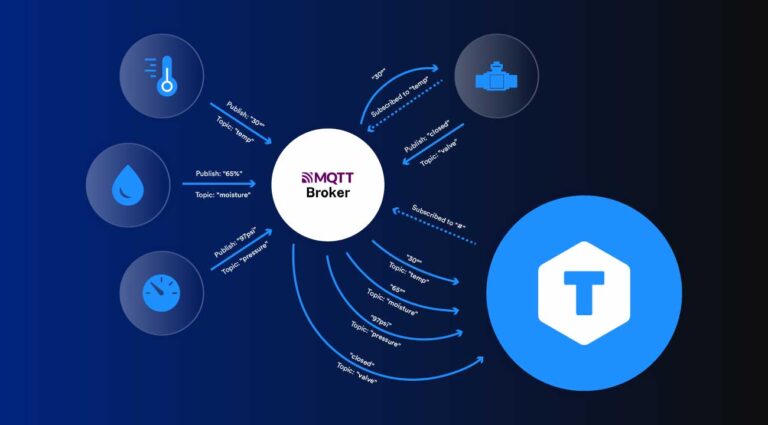Amidst the rising tides of competition, evolving tech, and supply chain shakeups, businesses are striving to modernize operations, improve agility, and unify fragmented systems; all of which require a reliable method of moving data across the enterprise.
Message Queuing Telemetry Transport, or simply MQTT, is a lightweight and efficient messaging protocol that has emerged as a standard for industrial communication. When combined with a modern Manufacturing Execution System (MES), like TrakSYS, MQTT helps manufacturers eliminate data silos, accelerate integration, and power intelligent decision-making at scale.
In this blog, we explore MQTT—what it is, practical use cases, and how it functions in conjunction with TrakSYS. With all that said, let’s take it from the top.
Table of Contents
What is MQTT?
MQTT is a protocol—or set of rules—for machine-to-machine communication. This protocol uses a publish/subscribe model to decouple the message sender and receiver. Additionally, there are three significant benefits worth noting when it comes to MQTT: scalability, streamlined connection, and real-time communication between shop-floor assets, edge devices, and the enterprise as a whole.
There are two components that make MQTT work—the broker and its clients:
The Broker: the backend system that coordinates messages between different clients. Responsibilities of the broker include:
- Receiving and filtering messages
- Identifying clients subscribed to each message
- Sending the messages
- Authorizing and authenticating clients
The Clients: any device that publishes data or subscribes to a broker. Common devices include sensors, wearables, and other IIoT devices.
Clients and brokers communicate via the MQTT connection. Clients initiate the connection with the broker, who confirms and manages it.

Why MQTT Matters in Manufacturing
Traditional industrial protocols such as OPC DA or Modbus RTU are based on point-to-point architectures. These tightly coupled connections create challenges when integrating across multiple vendors, systems, or platforms, often requiring custom code and middleware.
MQTT takes a different approach. Its publish/subscribe model decouples data producers (like machines or sensors) from data consumers (like MES, SCADA, or ERP systems). Clients send messages to a central broker, and any other client(s) subscribed to relevant topics receive the data in real-time. This architecture dramatically simplifies integration and allows for flexible, scalable communication across your operations.
For manufacturers, this means fewer integration headaches, more consistent data flow, and faster time to value.

History of MQTT
Originally developed in 1999 by IBM and Arcom, MQTT was designed to enable reliable communication over bandwidth-constrained and unstable satellite networks. Its lightweight architecture and low overhead made it ideal for remote industrial systems.
Over the last two decades, MQTT has evolved from a niche protocol into a powerful enabler of Industrial IoT. With its adoption as an open OASIS standard in 2014, MQTT became widely embraced for its publish/subscribe model, real-time data transmission, and ability to function efficiently across varying infrastructure. The protocol now plays a key role in digital transformation strategies, where latency, scalability, and system interoperability are paramount.
Unified Namespace: Creating a Common Language for Data
To reap the full benefits of MQTT, many manufacturers are also implementing a Unified Namespace (UNS). A UNS is a structured and centralized data architecture, often modeled after the ISA-95 standard, that creates a shared, contextualized space for all operational data.
Think of a UNS as your factory’s single source of truth. An MQTT-powered UNS allows information to flow seamlessly from machines and processes to applications across the enterprise, including MES, ERP, and cloud analytics tools.
This centralization of contextual data provides:
- Real-time operational visibility
- A consistent data hierarchy for integration
- A scalable foundation for future digital initiatives
With MQTT as the transport layer and UNS as the organizational model, manufacturers gain an agile, extensible framework that supports digital transformation across any number of sites or systems.
Sparkplug B: Making MQTT Industrial-Grade
While MQTT provides the backbone for messaging, it doesn’t define how industrial data should be structured or how systems should handle state changes. That’s where Sparkplug B comes in.
Sparkplug B is an open specification that enhances MQTT for industrial use. It introduces standardized payloads (using Google Protocol Buffers), clear device state tracking (through birth and death certificates), and session management features that ensure message reliability and interoperability.
By leveraging Sparkplug B, manufacturers can ensure that their MQTT infrastructure supports reliable, plug-and-play communication across multi-vendor environments, making integration quicker, simpler, and more consistent.
TrakSYS and MQTT: Built for Modern Manufacturing
TrakSYS includes native support for MQTT, enabling seamless connectivity between industrial assets, edge devices, and enterprise systems. Whether building out a UNS or simply looking for a more efficient way to share machine data, TrakSYS provides the tools to move quickly and confidently.
With MQTT, TrakSYS can:
- Subscribe to live machine telemetry in real time—no polling required
- Publish key events and production data to a central broker for wider access
- Integrate with both edge and cloud platforms using a secure, lightweight protocol
This capability positions TrakSYS as a natural fit for manufacturers looking to implement IIoT, UNS, or Industry 4.0 initiatives—all without the need for complex integrations or vendor-specific infrastructure.
Use Cases: TrakSYS + MQTT in Action
|
Use Case
|
How It Works
|
|
Real-Time Machine Monitoring
|
TrakSYS subscribes to live telemetry over MQTT to drive dashboards, alerts, and KPIs.
|
|
Production Event Streaming
|
TrakSYS publishes events (batch complete, machine fault, etc.) to the UNS for real-time visibility across platforms.
|
|
Operator Guidance
|
MQTT topics trigger TrakSYS workflows or display updated work instructions based on live machine states.
|
|
Predictive Maintenance
|
MQTT data feeds machine learning models in TrakSYS or external AI tools to identify early warning signs.
|
|
Cloud Analytics
|
TrakSYS publishes streamlined, contextual production data to brokers like AWS IoT Core or Azure IoT Hub for deep analytics.
|
Getting Started with MQTT and TrakSYS
To successfully implement MQTT in your MES strategy, it’s important to keep these best practices in mind:
Security: Ensure all MQTT traffic is encrypted via TLS and implement broker authentication and topic-level access controls to prevent unauthorized access.
Topic Structure: Design a clear, hierarchical topic namespace that reflects your operational structure (e.g., site/line/machine/tag). This makes it easier to manage, filter, and scale.
Broker Architecture: Choose a robust MQTT broker that fits your deployment strategy. Options include open-source tools like Mosquitto, enterprise platforms like HiveMQ, or cloud-native brokers from AWS or Azure.
Edge Context: Ensure MQTT messages include contextual data (such as tag descriptions, units, and timestamps) so TrakSYS can properly contextualize the information.
Conclusion
As manufacturers continue to modernize, seamless data integration is key to unlocking the potential of Industry 4.0.
MQTT provides a lightweight, real-time foundation for moving data across your digital thread, and with TrakSYS, manufacturers can turn that data into insight and action. With MQTT’s scalable architecture, manufacturing leaders can move faster, collaborate better, and make smarter decisions—from the factory floor to the boardroom.

